Both the Butterfly Orchids seem to have fewer and fewer spikes to show the world, although that could be down to the dry conditions Kent has experienced this year.
Something of all of the above has affected the Early Marsh Orchid, lover of freshwater meadows, most of which have been drained. A single site now remains for them in Kent, and that has been drying out for some time, now being infiltrated with Common Spotted, with which it hybridises, thus reducing numbers and being certain of "pure" Early Marsh difficult. And the site is about a 45 minute drive away, a long way to go to see a handful of plants you might think, but then I am the man who planned two holiday on seeing the Lindisfarne Helleborine, and when we did finally see a flowering spike, it was a scrawny spike with two flowers, but did it. So, 45 minutes? Nowt to worry about.
And as it was another glorious day in the Garden of Eden, what better way than to be up and about soon after getting up, going to see the Early Marsh and then onto see the Heath Spotted Orchids? None whatsoever.
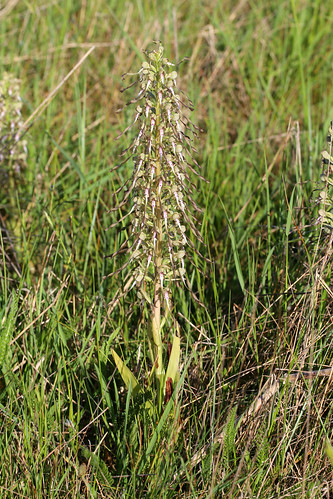 We were awake at six, drinking coffee by quarter past, and out of the house before seven, driving up to Sandwich first off, as yet another orchid species was showing. Those of you who know me and my politics will understand how divided I feel that a large privately owned estate is protector for a rare species, and charges seven quid just to dive onto their estate. They would argue you can walk free of charge along the beach. That there are patrols, the orchids that grow here are as well protected as any in Kent, even though last year a spike was stolen.
We were awake at six, drinking coffee by quarter past, and out of the house before seven, driving up to Sandwich first off, as yet another orchid species was showing. Those of you who know me and my politics will understand how divided I feel that a large privately owned estate is protector for a rare species, and charges seven quid just to dive onto their estate. They would argue you can walk free of charge along the beach. That there are patrols, the orchids that grow here are as well protected as any in Kent, even though last year a spike was stolen.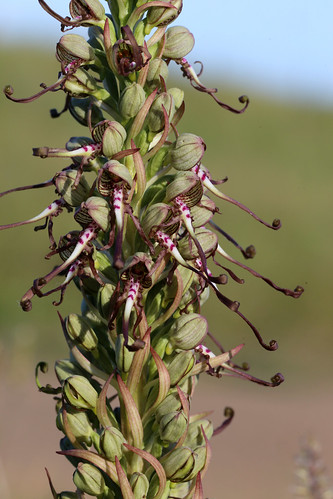 We could have traveled along the old coast road, past the golf courses, but mixing it with the Sunday morning cyclists. We possibly wouldn't have seen any at such an early time, but in the end I took the roundabout way, along the main road to Deal, over the marshes to Sandwich before turning for the estate. As planned, there was no guard on duty, so we were able to drive straight onto the estate. But if asked either by said guard, or had someone came round to ask for money, I would have paid. But seven quid better in my pocketses.
We could have traveled along the old coast road, past the golf courses, but mixing it with the Sunday morning cyclists. We possibly wouldn't have seen any at such an early time, but in the end I took the roundabout way, along the main road to Deal, over the marshes to Sandwich before turning for the estate. As planned, there was no guard on duty, so we were able to drive straight onto the estate. But if asked either by said guard, or had someone came round to ask for money, I would have paid. But seven quid better in my pocketses.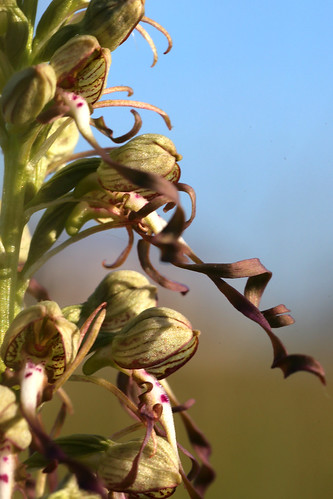 Some houses near to the beach actually have spikes on their front lawns, and possibly back ones too, some were sheltering against a south facing wall, reaping reflected heat from it, they were looking in very good shape. And then all along the dunes between the road and beach, hundreds of spikes could be seen. We go right down to the bottom of the site, near yet another gold course, but here there are plenty of Lizard Orchid spikes, broomrapes, and hiding in the long grass beside the road, a single Bee, seemingly doing well yet almost invisible to the outside world. But not to my orchid eyes.
Some houses near to the beach actually have spikes on their front lawns, and possibly back ones too, some were sheltering against a south facing wall, reaping reflected heat from it, they were looking in very good shape. And then all along the dunes between the road and beach, hundreds of spikes could be seen. We go right down to the bottom of the site, near yet another gold course, but here there are plenty of Lizard Orchid spikes, broomrapes, and hiding in the long grass beside the road, a single Bee, seemingly doing well yet almost invisible to the outside world. But not to my orchid eyes.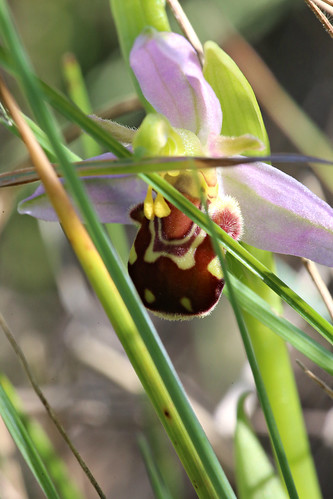 I have been here for the last four years, snapping the Lizards, so after a few spikes, it would just be repeating shots, so with many miles to go, we get back in the car and make our way back to Sandwich then up to Thanet Way for a blast along the A2 and motorway to the Medway towns for our next call.
I have been here for the last four years, snapping the Lizards, so after a few spikes, it would just be repeating shots, so with many miles to go, we get back in the car and make our way back to Sandwich then up to Thanet Way for a blast along the A2 and motorway to the Medway towns for our next call.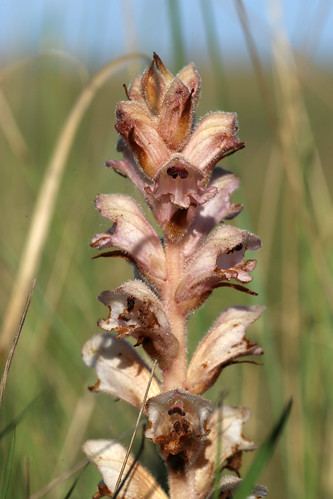 At the back of an industrial estate, on a street lined with signs warning you not to park here. Or here. Or here, through a subway under the railway, then climb over a 5 bar gate; there is the reserve.
At the back of an industrial estate, on a street lined with signs warning you not to park here. Or here. Or here, through a subway under the railway, then climb over a 5 bar gate; there is the reserve.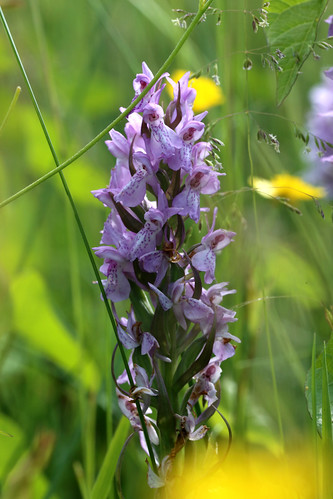 And in fact, despite it being such a dry year, it was still damp underfoot. With the reserve being several hundred metres long, finding the spikes would be tricky. I had been here just once before, and from the depth of my memories, I tried to remember where I had seen the Early March. I walked on, damselflies scattering in all directions as I worked my way through following tracks that were barely there. I see a few CSO spikes, and what might be Marsh Orchids too, but not what I was seeking.
And in fact, despite it being such a dry year, it was still damp underfoot. With the reserve being several hundred metres long, finding the spikes would be tricky. I had been here just once before, and from the depth of my memories, I tried to remember where I had seen the Early March. I walked on, damselflies scattering in all directions as I worked my way through following tracks that were barely there. I see a few CSO spikes, and what might be Marsh Orchids too, but not what I was seeking.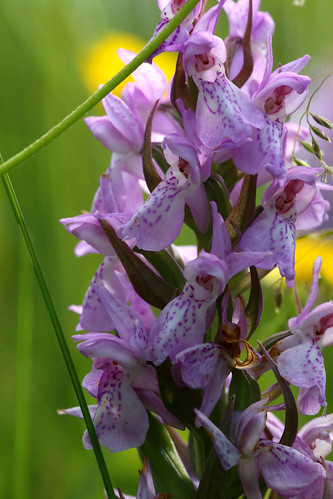 Early Marsh are quite distinctive, said the orchidist, but really, the lips of the flowers are pressed backwards, and mostly of a pale pink colour. Once seen never forgotten. But I could now see the far fence of the site, and had not seen one Early Marsh, I was worried. One last clearing and I see many more spikes than I had seen thus far. And standing side by side were two, partially faded, Early Marsh. I get down to photograph them, and in doing so see one more hidden in the undergrowth behind. One more was found on the other side of the clearing, but that was it; four spikes.
Early Marsh are quite distinctive, said the orchidist, but really, the lips of the flowers are pressed backwards, and mostly of a pale pink colour. Once seen never forgotten. But I could now see the far fence of the site, and had not seen one Early Marsh, I was worried. One last clearing and I see many more spikes than I had seen thus far. And standing side by side were two, partially faded, Early Marsh. I get down to photograph them, and in doing so see one more hidden in the undergrowth behind. One more was found on the other side of the clearing, but that was it; four spikes.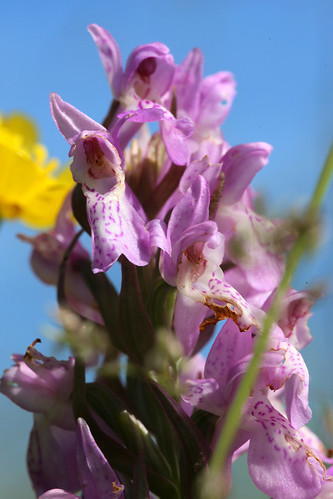 I had parked where some of the drivers from the haulage firm on the other side of the road parked, but I worried about getting a ticket or clamped, so we walked back to the car, from a wonderful site, marked with no signs or boards until you actually get to it, hidden in an ugly industrial estate. Beauty and ugliness, side by side.
I had parked where some of the drivers from the haulage firm on the other side of the road parked, but I worried about getting a ticket or clamped, so we walked back to the car, from a wonderful site, marked with no signs or boards until you actually get to it, hidden in an ugly industrial estate. Beauty and ugliness, side by side.We make for the M20, taking this road for the first time since we traveled to Japan, we both remembered that trip, both thinking we would not get there in time. Onto the motorway, where traffic was heavier now that others had woken up, and there was sunshine to enjoy the day in.
I take the A20 from Maidstone, take the less-traveled road, and just enjoying the day once again as we drove eastwards towards Hothfield. Kent is a fairly large county, but even so has a wide range of habitats from chalk downland, ancient woods, Britain's only officially declared desert, drained marshland and an acid bog. And it was to the acid bog we were going to, as it is the acidic shoil that the Heath Spotted Orchid craves.
What separates the CSO from the HSO, Ian? Glad you asked, he lied. Well, lip shape. And that is about it really. The CSO will not grow in such soil, not sure how close they are related, but the curving edge to the lower lip is the giveaway. Anyway all species have been DNA tested to show they are different, so, anyway another species, and which was the most recent new Kent species for me which I first saw a year ago thanks to my friend Mark, who took us here.
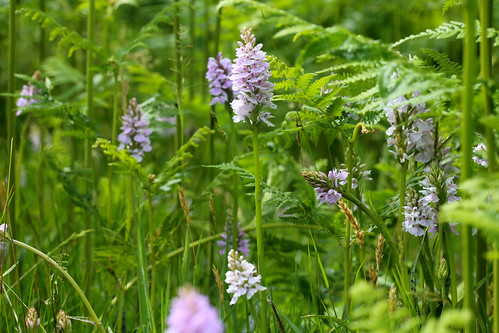 We park in the woods, then walk through what seems to be ancient woodland, then across heathland, looking very much like parts of Scotland, more so when we clock the herd of Highland Cattle in a fenced off area.
We park in the woods, then walk through what seems to be ancient woodland, then across heathland, looking very much like parts of Scotland, more so when we clock the herd of Highland Cattle in a fenced off area. 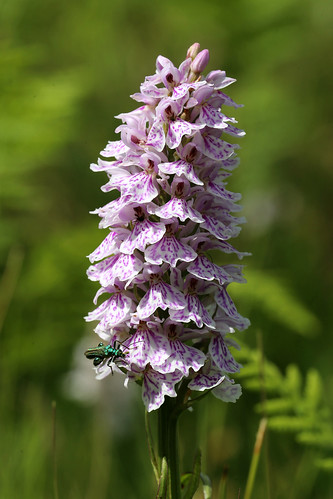 Surrounding a bog is where the orchid grow, in soil that is damp, and acid. Soon I see the first of the spikes, and as I walk round the western side of the bog I see over a hundred spikes, some in very good state and some quite large too.
Surrounding a bog is where the orchid grow, in soil that is damp, and acid. Soon I see the first of the spikes, and as I walk round the western side of the bog I see over a hundred spikes, some in very good state and some quite large too.
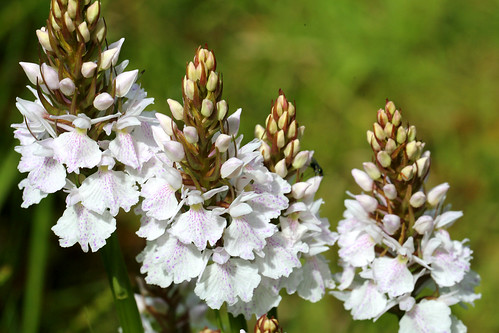 I take some shots, not a huge amount, and also hunt for a pure var. alba, but don't find one, some near too being, but not close enough, as it turns out. We walk the boardwalk out over the nearly dry pool, see the sundew still thriving although there was very little water, and the Bog Cotton had already gone to seed, and the breeze was blowing seeds across the water.
I take some shots, not a huge amount, and also hunt for a pure var. alba, but don't find one, some near too being, but not close enough, as it turns out. We walk the boardwalk out over the nearly dry pool, see the sundew still thriving although there was very little water, and the Bog Cotton had already gone to seed, and the breeze was blowing seeds across the water.We were done, so walk back to the car, walking with dog walkers, exercising their hounds, including one with three legs who got about very well.
We were driving to the coast, heading home as most people were just heading out, which is great, considering what we had done already that day. We get home in time for lunch, and it was to be a very late breakfast of bacon butties made with sweetcure streaky bacon, a real favourite for us, soo the house was filled with sweet bacon smells, as soon would our bellies!
There is much to do in the afternoon; blogs to write, photos to review and edit, shots to post, and the garden to de-poppy. We had lots of seeds left over, and Jools scattered them in the Imperialis beds so to create colour in late spring. What it did create was a tangle of stems, flowers popping and fading, and the jumble becoming a haven for snails. It also looked a mess. So, bed by bed we removed the poppies, and in doing so made the garden look 80% tidier. THe lawn still cannot be mowed, at least until the end of July when the Yellow Rattle have dried, then we can collect the seed, broadcast that, then harvest the grass and maybe make hay.
I cook chorizo hash for dinner, a pop open some fizz to go with it. Its the end of a fine weekend, one which we have seen and done lots, but now Monday calls, a return to work. But there is time to sit in the garden, sip home made sloe port and watch dusk fade and the stars and bats come out to play.

No comments:
Post a Comment